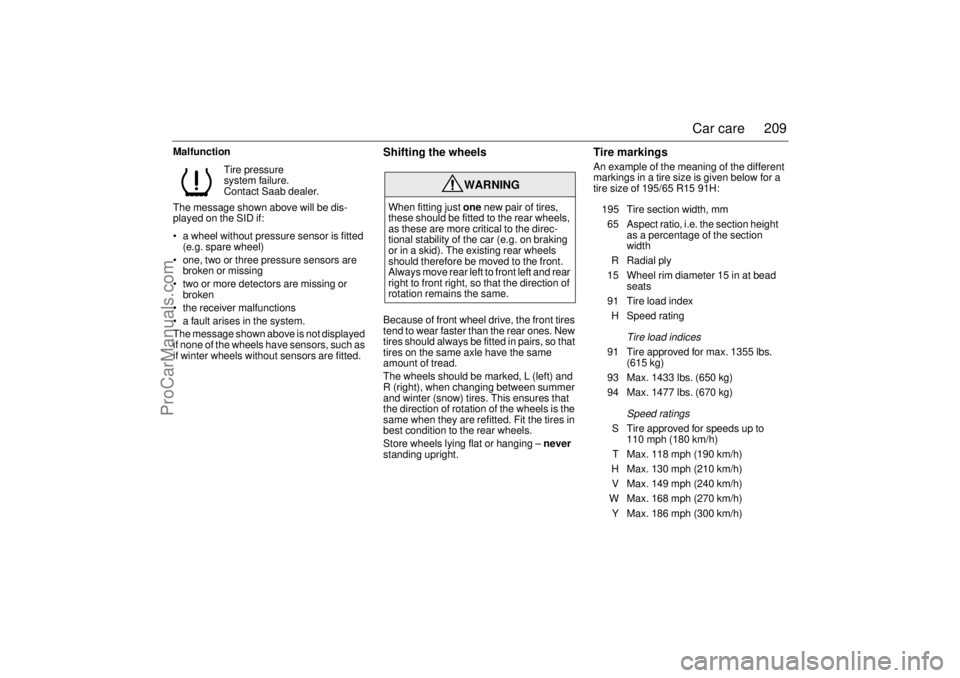sensor SAAB 9-3 2003 Owner's Guide
[x] Cancel search | Manufacturer: SAAB, Model Year: 2003, Model line: 9-3, Model: SAAB 9-3 2003Pages: 256, PDF Size: 21.66 MB
Page 209 of 256

209 Car care
Malfunction
The message shown above will be dis-
played on the SID if:
a wheel without pressure sensor is fitted
(e.g. spare wheel)
one, two or three pressure sensors are
broken or missing
two or more detectors are missing or
broken
the receiver malfunctions
a fault arises in the system.
The message shown above is not displayed
if none of the wheels have sensors, such as
if winter wheels without sensors are fitted.
Shifting the wheelsBecause of front wheel drive, the front tires
tend to wear faster than the rear ones. New
tires should always be fitted in pairs, so that
tires on the same axle have the same
amount of tread.
The wheels should be marked, L (left) and
R (right), when changing between summer
and winter (snow) tires. This ensures that
the direction of rotation of the wheels is the
same when they are refitted. Fit the tires in
best condition to the rear wheels.
Store wheels lying flat or hanging – never
standing upright.
Tire markingsAn example of the meaning of the different
markings in a tire size is given below for a
tire size of 195/65 R15 91H: Tire pressure
system failure.
Contact Saab dealer.
WARNING
When fitting just one new pair of tires,
these should be fitted to the rear wheels,
as these are more critical to the direc-
tional stability of the car (e.g. on braking
or in a skid). The existing rear wheels
should therefore be moved to the front.
Always move rear left to front left and rear
right to front right, so that the direction of
rotation remains the same.
195 Tire section width, mm
65 Aspect ratio, i.e. the section height
as a percentage of the section
width
R Radial ply
15 Wheel rim diameter 15 in at bead
seats
91 Tire load index
H Speed rating
Tire load indices
91 Tire approved for max. 1355 lbs.
(615 kg)
93 Max. 1433 lbs. (650 kg)
94 Max. 1477 lbs. (670 kg)
Speed ratings
S Tire approved for speeds up to
110 mph (180 km/h)
T Max. 118 mph (190 km/h)
H Max. 130 mph (210 km/h)
V Max. 149 mph (240 km/h)
W Max. 168 mph (270 km/h)
Y Max. 186 mph (300 km/h)
ProCarManuals.com
Page 219 of 256

219 Car care
thoroughly at the end of winter. Clean the
underside of the car by hand if the car is usu-
ally washed in an automatic car wash with-
out special facilities for underbody cleaning.
Never wash or leave the car to dry in the
sun, but wipe it dry with a chamois leather
immediately after washing to avoid smears
and streaks.
Clean the inside of window glass using a
proprietary window cleaner. This is particu-
larly important when the car is new, as
upholstery and trim have a tendency to
sweat a little at first.
Keep the glass well polished, as this helps
to prevent misting.
Clean the outside of the windows with Saab
washer fluid. This is especially important if
the car has been washed in an automatic
car wash, as sometimes a wax treatment is
used that can contaminate the windshield
and impair the performance of the wipers.
Waxing and polishingDo not wax a new car during the first three
or four months. In fact, there is no need to
polish the car before the paintwork has
started to go dull through oxidation. Other
than in exceptional cases, do not use abra-
sive polishes containing a cutting agent on
a new car. Always wash the car thoroughly
before waxing or polishing.
Touching up the paintDamaged paintwork should be treated as
soon as it is discovered: the longer it is left,
the greater the risk of corrosion. The anti-
corrosion warranty does not cover corrosion
resulting from untreated defects.
Paintwork damage sustained in a crash is
usually extensive and can only be properly
restored by professionals.
However, you can repair small scratches
and stone chip damage yourself. The nec-
essary tools and materials, such as primer,
touch-up paint and brushes, are available
from your Saab dealer.
In the case of minor flaws in the paintwork,
where the metal has not been exposed and
an undamaged layer of paint remains,
touch-up paint can usually be applied
directly, after any dirt has been scraped
away using a pointed knife.
If corrosion has already set in, such as the
result of stone-chip damage, use a pointed
knife to scrape off all surface rust. If possi-
ble, the damaged area should be taken
back to the bare metal. The metal should
then be primed with two thin coats of primer
applied by brush.
After the primer has dried, apply several thin
layers of topcoat until the surface of the
repaired area is flush with the surrounding
paintwork.
Stir both primer and touch-up paint thor-
oughly before use and allow each coat to
dry before applying the next.
NOTICE Try your brakes on leaving a car wash.
Wet brake discs reduce the perfor-
mance of the brakes.
Fixed antennae, such as for a mobile
phone, must be removed if the car
goes through an automatic car wash.
Cars with Saab Parking Assistance:
Do not spray the sensors or closer
than 8 in. (20 cm) to the sensors with
a pressure washer, as this can
damage them.
ProCarManuals.com
Page 248 of 256

248 Technical dataSeveral of the systems in your Saab
can be customized to better suit
your individual needs. Contact your
Saab dealerCentral locking system
Some functions are governed by legal
requirements and cannot therefore be
reprogrammed.
Consult a Saab dealer for further informa-
tion.
Listed below are a number of examples of
programmable functions.
Audible confirmation of arming/disarming
the car alarm.
Automatic unlocking when car stopped
and remote control removed from the igni-
tion switch.
Trunk lid locked when car driven off or
30 s after being shut.
Length of audible and visual acknowl-
edgements.
Possibility to have the trunk lid unlocked
when doors unlocked, yes/no.
Central locking relocks the car automati-
cally if a door or the trunk lid is not opened,
yes/no. If the car has an alarm, this is
rearmed.Car alarm
Listed below are a number of examples of
programmable functions.
Cabin lighting switched on when the car
alarm is tripped.
Sensitivity of the movement sensor.
Audible signal produced by horn or car
alarm siren.
ProCarManuals.com
Page 250 of 256

250 Technical data
Rear left seat backrest
unlocked.
Rear right seat backrest
unlocked.
Parking assistance malfunction.
Contact Saab dealer.
Parking assistance sensor
interference.
Close doors.
Left brake light failure
Left high beam failure.
Left low beam failure.
Rear fog light failure.
Right brake light failure.
Right high beam failure.
Right low beam failure.
High mounted brake light
failure.
Left front turn signal
failure.
Left rear turn signal
failure.
Right front turn signal
failure.
Right rear turn signal
failure.
Left rear position light
failure.
Right rear position light
failure.
Tire pressure
system failure.
Contact Saab dealer.
Tire pressure low,
rear left.
Check tires.
Tire pressure low,
rear right.
Check tires.
Tire pressure low,
front right.
Check tires.
Tire pressure low,
front left.
Check tires.
Flat tire rear left.
Make a safe stop.
Flat tire rear right.
Make a safe stop.
Flat tire front left.
Make a safe stop.
Flat tire front right.
Make a safe stop.
Time for service.
ProCarManuals.com
Page 253 of 256

253 Index
LLATCH (child safety)
_____________ 22
Labels and plates, location
_______ 246
Lashing eyes
__________________ 118
Laying the car up
______________ 150
Leather upholstery, cleaning
______ 218
Limp-home
___________________ 126
Limp-home, automatic transmission
137
Load carriers, roof
______________ 161
Load indices, tyres _____________ 209
Load-through hatch _____________ 117
Locking a car with flat battery
______ 41
Locks
________________________ 38
Long-term parking
______________ 150
Luggage compartment
__________ 116
Luggage compartment lighting
106
, 119
Luggage compartment lighting,
changing
____________________ 197
MMAXI fuses
___________________ 200
Main instrument panel
___________ 54
Main/dipped beam
______________ 72
Maintenance schedule __________ 230
Manual climate control ___________ 79
Manual gear selection ___________ 139
Manual gearbox
_______________ 133
Manual tripping of car alarm
_______ 49
Materials used in the car, reclamation
222Memory, driver’s seat
____________ 19
Milometer
_____________________ 59
Movement sensor, car alarm
______ 48
Mug holder
___________________ 107
NNight driving
__________________ 163
Number plate lighting, changing
___ 196
OORVR
_______________________ 174
Oil capacity, engine
_____________ 239
Opening handles
________________ 38
Opening the fuel filler flap manually
_52
Owner assistance
______________ 232
PPanic function, car alarm
_________ 49
Park Brake Shift Lock
___________ 135
Park Brake Shift Lock,
temporary override
____________ 137
Parking
______________________ 148
Parking aid ___________________ 151
Parking brake _________________ 148
Parking on a hill _______________ 149
Pinch protection, electric windows
_100
Pinch protection, sunroof
________ 104Plates and labels, location
________ 246
Polishing and waxing
____________ 219
Poly-V-belt
____________________ 185
Position lights __________________ 72
Power steering fluid, checking
_____ 181
Power steering fluid, grade
_______ 242
Pressure gauge
_________________ 61
Profiles, customized settings
_______ 64
Puncture, changing wheels _______ 214
QQuick guide, remote control
_______ 39
RRain sensor
____________________ 77
Rear fog light ___________________ 74
Rear seats, folding down
_________ 116
Rear towing eye
_______________ 165
Rear window heating
_____________ 83
Rearview mirrors
_______________ 110
Recirculation
___________________ 82
Recommendations for automatic
transmission, towing a trailer
____ 158
Recommendations for manual
gearbox, towing a trailer
________ 159
Recommended fuel grades _______ 128
Recommended snow chains ______ 243
Refueling
_____________________ 128
ProCarManuals.com